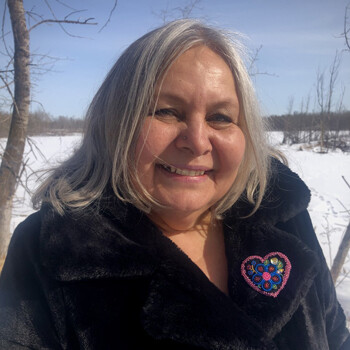Asking the Questions of Land Acknowledgement Through Art

This spring we caught up with Ariane Inman, the Beaver Hills Biosphere’s inaugural visual arts laureate, to learn more of her experience as laureate and find out how her project is progressing.
During her tenure as the Visual Arts Laureate, Ariane is taking a series of photographs, capturing residents of the Biosphere. Her work is invested in human connections to the flora and fauna of the Biosphere, capturing the natural beauty of places like Elk Island National Park. But at the heart of her work is land acknowledgement -- how those who call the Biosphere home connect to their place in nature, their ancestors and this historic landscape. Ariane explains what that means to her and how she is incorporating it into her project.
“The concept behind my project centers on the questions of land acknowledgement, like, how did we come to be here? How do we care for the place where we live?” Ariane explains. “I think it’s important that we acknowledge the land where we live.”
But it's not just about how we relate to nature or a specific place. Ariane says it’s also how we relate to the humans and the nonhumans where we live as well. Who has lived here before us?
Focusing on land acknowledgement brings together different threads for Ariane, who says that land acknowledgement too often is minimized or turned into just another box to tick. It can become an email signature or it’s not uncommon now to see coffee shops display framed land acknowledgements or to hear an acknowledgement before a play. Yet we rarely consider what those acknowledgements mean or how we connect to them personally. Land acknowledgements have become corporatized, ironically disconnected from the people and places they are meant to recognize.
Powerful art provokes questions and inspires inquiry. For Ariane’s work, and the questions of land acknowledgement, this is particularly important.
“I want to take photos of people who live or work in the Biosphere, those who have an interesting relationship with nature, and photograph them outside,” explains Ariane. “While I’m doing that, I’m also asking them the questions of land acknowledgement, as a form of gentle self-inquiry.”
Growing up in a small town on the Bay of Fundy from the time she was four, Ariane often felt disconnected from her Métis heritage and Winnipeg where she was born. Later, as a young adult in New Brunswick, she was mentored by Mary Makja, who started the Shorebird Reserve at Mary’s Point. It was while working with Mary that Ariane found the ‘spark’ that ignited her interest in nature.
The human lineage of place matters as much as the natural and Ariane has also found ways to reconnect with her ancestors through her artistic practice. Her own story in the Biosphere is one of connecting with her own roots. While visiting Elk Island, she saw her first bison. It is by returning to Elk Island and connecting to the land the bison roam on that Ariane has found a new connection with her ancestors. It’s these types of connections Ariane also seeks in her subjects.
Today, her work as the Biosphere’s visual arts laurate enables her to be out in nature with her camera again and the portraits she captures set the people who live in the Biosphere within the landscape.
Through her photographs, Ariane brings together the different threads of the Biosphere – nature, science and culture. She does this by meeting people out in nature, going for a walk and capturing them in place. When they connect on these strolls through the woods, Ariane also gets to engage people in her own passion for nature, especially birding.
Her first portrait subject was Connie Kulhavy, a Métis artist and cultural teacher who works with kids in the Beaver Hills Biosphere.
“I chose Connie for my project because she teaches Métis culture in the public school system and is influencing a whole generation of kids in the Biosphere,” explains Ariane. “I’m glad Connie is out there doing this work weaving threads and beads together repairing broken circles and making new ones.”
They went for a walk at Elk Island a few weeks ago and she asked Connie the questions in her project but mostly they just talked and walked with Ariane’s partner Mel. They talked about how trees talk to each other, how things that don’t necessarily seem connected are connected in nature.
When asked why this approach is important to her project, Ariane replies, “I want to find the unique connections people have interacting with nature because I don't think people can be healthy human beings without having a good relationship to nature and the place where they live.”
As she continues photographing people in the places of the Biosphere, Ariane builds greater connections of her own with this special place. And as she asks the questions of land acknowledgement of her subjects, her own connection to this place deepens.
“My hope is that by connecting with answers to questions of land acknowledgement, like ‘How did I come to be here?’, ‘How did my ancestors come to be here?’ and more, people can better relate to nature and the community where they live,” Ariane explains.